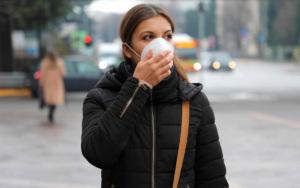Classroom Connection: COVID-19 conspiracy theory outbreak
 A baseless conspiracy theory about the COVID-19 pandemic migrated from fringe internet communities into more mainstream conversations last week, spreading dangerous doubt about the seriousness of the pandemic across the United States and around the world.
A baseless conspiracy theory about the COVID-19 pandemic migrated from fringe internet communities into more mainstream conversations last week, spreading dangerous doubt about the seriousness of the pandemic across the United States and around the world.
The theory — that the pandemic is a staged hoax or “false flag” event — had emerged among anti-vaccination and QAnon communities online by mid-March. But the idea was galvanized on social media following a powerful March 25 New York Times report featuring video of Colleen Smith, an emergency room doctor at Elmhurst Hospital in Queens. She provided a firsthand account and video of conditions at the hospital the day before, when 13 people died of COVID-19.
Three days later, Twitter user @22CenturyAssets tweeted: “#filmyourhospital Can this become a thing?” Hours later, the far-right talk radio host Todd Starnes tweeted (archived here) a video of “not much happening” at the Brooklyn Hospital Center — his neighborhood hospital. He said he did so to highlight “what’s really going on out here instead of what the mainstream media is telling you.”
COVID-19 conspiracy spreads
By the following day, more than a dozen photos and videos said to have been shot outside hospitals across the U.S. and around the world had been tweeted with the #FilmYourHospital hashtag. In posts on April 1 and 2, influential QAnon adherents attempted to discredit Smith on Twitter and YouTube. They falsely claimed that she did not actually work at Elmhurst Hospital, They also misinterpreted her background in medical simulation training, and picked apart the video she provided to the Times.
Also fanning the flames of the #FilmYourHospital conspiracy movement was CBS News’ March 30 acknowledgment that it had erroneously used several seconds of footage of a crowded hospital in Italy in a March 25 report (go to 0:45 for the clip) about the impact of COVID-19 on hospitals in New York City. CBS News has offered no further explanation about its mistake.
Safety and privacy issues
Safety and patient privacy concerns largely prevent the press from providing the public with photos and videos from inside hospitals, where the realities of the pandemic are most apparent. That may help explain why this has become such a focal point of conspiracy communities online.
Also note that another widespread conspiracy theory falsely connecting 5G cell towers to the COVID-19 pandemic spiked online last week. It led to a spate of viral rumors — including a variety of false claims that governments are faking the public health crisis to distract the public and push through dangerous new technologies.
Related:
- “What We Pretend to Know About the Coronavirus Could Kill Us” (Charlie Warzel, The New York Times).
- “British 5G towers are being set on fire because of coronavirus conspiracy theories” (Tom Warren, The Verge).
- “YouTube moves to limit spread of false coronavirus 5G theory” (Alex Hern, The Guardian).
- “The latest wildly false COVID-19 conspiracy theory puts the blame on 5G” (Ruth Reader, Fast Company).
- “Here’s why 5G and coronavirus are not connected” (Bob O’Donnell, USA Today).
Discuss: Why are people drawn to conspiracy theories? In what ways could these conspiracy theories about COVID-19 be dangerous? What can we learn from the way the false notion that the pandemic is a hoax went mainstream with the #FilmYourHospital hashtag? How can we work to stop such theories from spreading? Can people be inoculated against conspiratorial thinking? How?